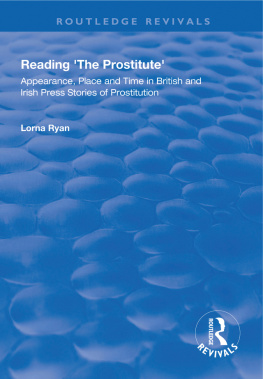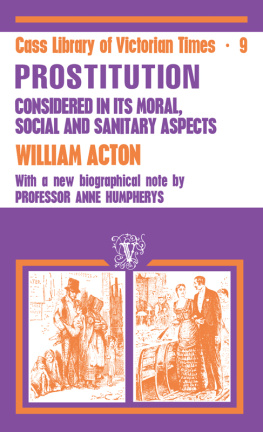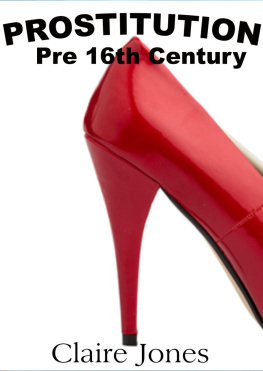Reading 'The Prostitute'
Reading 'The Prostitute'
Appearance, Place and Time in British and Irish Press Stories of Prostitution
Lorna Ryan
Department of Sociology and Social Anthropology, University of Kent and Department of Social Studies, Trinity College, Dublin
First published 1997 by Ashgate Publishing
Reissued 2018 by Routledge
2 Park Square, Milton Park, Abingdon, Oxon, OX14 4RN
711 Third Avenue, New York, NY 10017, USA
Routledge is an imprint of the Taylor & Francis Group, an informa business
Copyright L. Ryan 1997
All rights reserved. No part of this book may be reprinted or reproduced or utilised in any form or by any electronic, mechanical, or other means, now known or hereafter invented, including photocopying and recording, or in any information storage or retrieval system, without permission in writing from the publishers.
Notice:
Product or corporate names may be trademarks or registered trademarks, and are used only for identification and explanation without intent to infringe.
Publisher's Note
The publisher has gone to great lengths to ensure the quality of this reprint but points out that some imperfections in the original copies may be apparent.
Disclaimer
The publisher has made every effort to trace copyright holders and welcomes correspondence from those they have been unable to contact.
A Library of Congress record exists under LC control number: 97070892
ISBN 13: 978-1-138-32415-2 (hbk)
ISBN 13: 978-1-138-32418-3 (pbk)
ISBN 13: 978-0-429-45102-7 (ebk)
I would like to thank a number of people for their support, encouragement and critical commentaries over the course of carrying out this research. Staff of the Department of Sociology, Trinity College Dublin, have been interested in and encouraging of this work. Brian Torode, Trinity College Dublin, has, over the past decade, been especially unfailing in his support for and constructive criticism of the various research projects, including that reported here, which I have carried out. From him I have learned much about the rigorous and systematic nature of qualitative research. Howard Davis, University of Kent, provided support and constructive criticism of my work. Mary Mcintosh, University of Essex, and Mary Evans, University of Kent, gave helpful comments. Jacqui Halson, University of Kent, combined much valued friendship and hospitality with sociological discussion.
Thanks to friends who acted, often involuntarily, as sounding boards for monologues about prostitution and other issues raised in this work. In particular I would like to thank Anne Keogh, Alison and John Lean, Stevie Tobin, Moirin Moynihan, Frankie Lynch and Ann Bond. I would also like to acknowledge the staff of the Lecky Library (Trinity College Dublin), including Paul, Sen, Sinad, Eileen, Tony and Claire. Thanks to Jacqui Akkouh and staff at Avebury. Anne O'Neill rescued me from the horrors of typesetting and I extend my heartfelt thanks to her for efficiency and speed in preparing this manuscript.
Copyright permission was obtained for the photographs reproduced (Appendix III):
- Guardian Newspapers Limited, 1989
- James Stracham, 1990
- David Rooney, 1987
Prostitution, particularly the prostitution of women, has long been the concern of thousands of writers worldwide. This book is about broadsheet newspaper stories of prostitution. It was a project which began with a specific concern to document what the Irish and British press were saying about prostitutes and prostitution. There is a paucity of empirical research on this topic and the study is thus an exploratory one. My interest in the subject of prostitution stemmed from a more general interest in the area of sexuality and also from an interest in the divisive debates amongst feminists about the role of prostitution in contemporary Western societies. I was also interested in the role of the medium of the press and in media discourses generally.
When I started collecting broadsheet press articles about prostitution I was struck by how they did not conform to my expectations there were no overt instances of sexist language, the 'whore image' to which feminists referred was not readily identifiable. The absence of what I would have seen as 'negative language' sent me back to the literature, a corpus dealing with historical, medical, psychopathological, and sociological aspects of prostitution. However, even armed with these diverse knowledges gave me no immediate handle on my textual materials. My sense of puzzlement cannot be understated why were my materials, ever increasing in number, taken from the broadsheet press in two countries, so unremarkable? My attempt to find an answer to this question led me to a number of different methods of textual analysis, to further forays into the enormous literature on prostitution, on women's sexuality, on language or discourse. But to no avail. My initial aim of writing about the broadsheet press' coverage of prostitution seemed at that juncture to be misguided. One aim of this book is to provide a naturalistic account of a research study. In this sense it follows John Maxwell Atkinson's seminal work , Suicide: Studies in the Social Organisation of Sudden Death (1982) and the initial problems Atkinson encountered were those I was to later engage with in this study. I was able to make sense of the problems I encountered through an engagement with the work of the ethnomethodologists.
The ethnomethodological enterprise, pioneered by Harold Garfinkel and Harvey Sacks, claims to reorientate sociological enquiries, a reorientation which is based upon a shift from 'why' to 'how' questions about the social order. Crucially, at least for this study, one of its central features is its exhortation to sociologists to view the obvious, mundane and commonplace features of social life as 'anthropologically strange'. The research question about press articles on prostitution (and prostitutes) was radically reformulated along the lines suggested by ethnomethodology. What was said about prostitutes was no longer of prime interest, rather, how the newspaper texts could be said to be about prostitution/prostitutes at all became the central research question. In this way, I was concerned to explicate common sense methods of reasoning which I as analyst had initially unthinkingly relied upon. In short, it meant that I followed the ethnomethodological injunction to treat resource as topic, to be truly reflexive in relation to my analysis of my materials.
The analysis employed demonstrates that the press accounts of the activities of prostitutes and of the prostitutes themselves use descriptions of appearance, place and time in providing for, in ethnomethodological terms, 'recognisably correct' categorisations. Questions of motive and intent are central to the unequivocal categorisation of women as 'prostitutes'. This categorisation is based upon culturally specific understandings of types of women and types of activities which are used by both journalists and readers, including analysts. Reading is thus dialogical. The title of thisbook, Reading 'TheProstitute', aims to encapsulate this process, and it involves both the textual and the visual. In regard to the latter, press pictures have been overlooked by many theorists of the press, a neglect which this study aims to rectify.
An overview of the study is provided in and the developments and revisions made over the course of the study are elaborated throughout the book.









